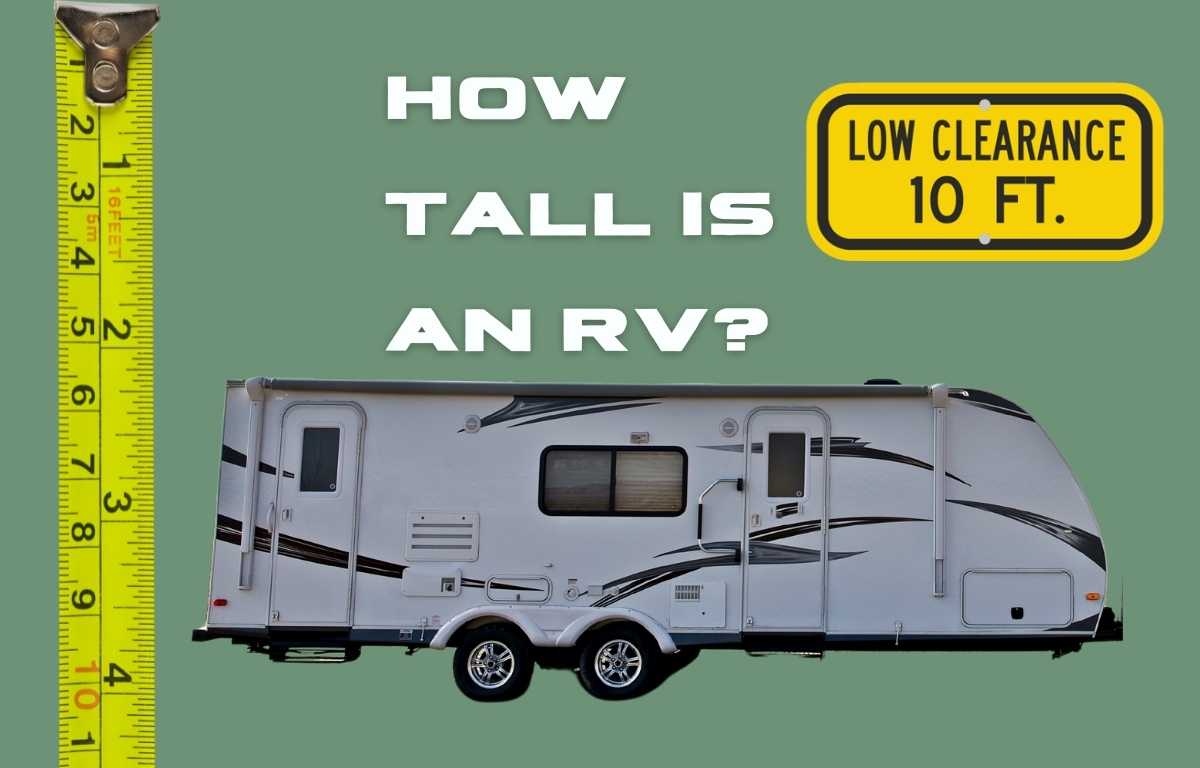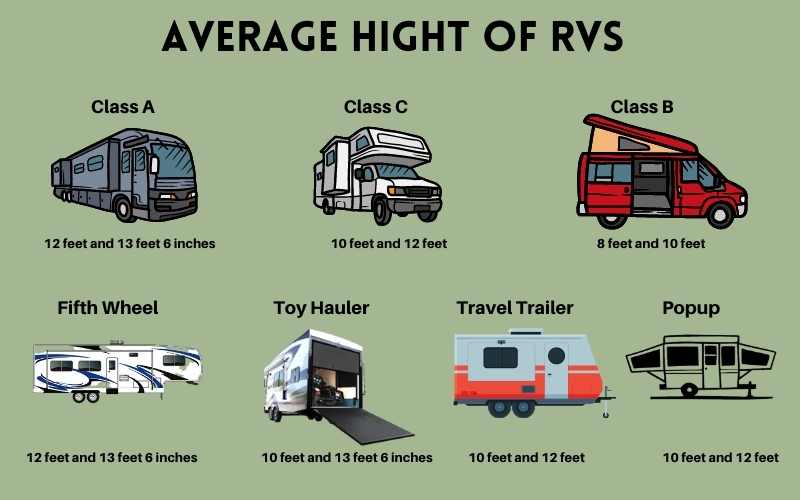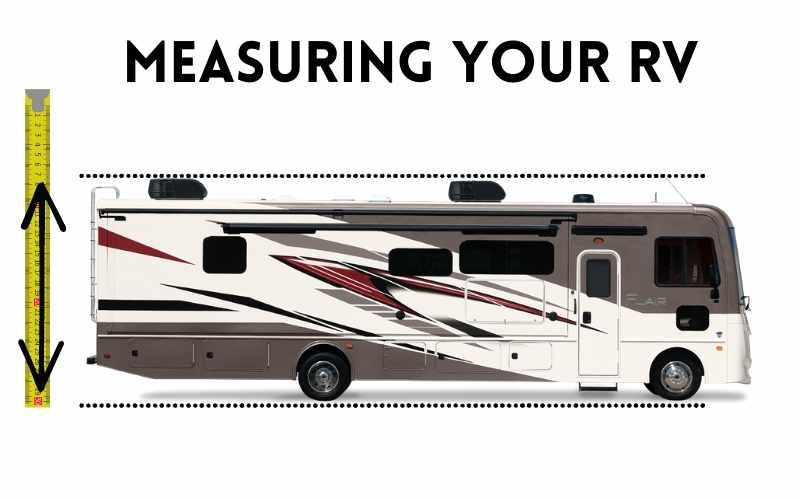If you have a Recreational Vehicle (RV) or looking to purchase one, you may have wondered how tall an RV is. If you’re an RV owner, this is an important number you will want to know. Likewise, it may also be a specification you need to consider when shopping for an RV. RVs come in all different sizes, which include the RV’s height. Knowing the size of your RV, including height, weight, overall length, and width, will help you plan your trips and when on the road.

There are several reasons RV owners want to know the height of their RV, with the key reason being to ensure you don’t hit something while traveling. Luckily, most RVs are well within the specifications of most obstacles you’ll encounter on the road. However, the low clearance obstacles still exist, and you don’t want to wonder if you’ll clear them or, even worse, knock off your air conditioner while maneuvering through a tight spot. Knowing your RV height is one of the most important things you can do to prevent damage to your roof.
Average height of an RV
The average RV height largely depends on the type of RV. However, even similar style RVs can have vastly different heights. The only way to truly know the height of your RV is to measure it. This number is also usually available in the owner’s manual or the manufacturer’s website, but it’s always smart to double-check and write down the number.
RV types typically fall within a certain height range. A Class A RV or Fifth Wheel will have the largest height for most RVs. These can be as tall as 13’6”. Conversely, a Class B Campervan van measures at the opposite end of the spectrum, with a height of as little as 9 feet.

Class A RVs
Class A motorhomes are one of the tallest RVs, measuring between 12 feet and 13 feet 6 inches. The increased height is due to the ceiling height and chassis height. Since some motorhomes may have airbags that will lower the RV when parked, it’s important o measure your RV when fully raised and ready for travel.
Class C RVs
Class C motorhomes, which are smaller in stature than Class A Motorhome, will typically be a little shorter. The average height of a Class C RV is between 10 feet and 12 feet.
Class B RVs
Class B motorhomes, or campervans, are the shortest of the drivable RVs. They range in height between 8 feet to 10 feet. However, Class B enthusiasts love to attach items to their roof, such as racks, recreational equipment, antennas, etc. So, before you rely on the manufactures height spec, it’s best to take a close look at your setup and measure. A class B RV can easily approach the height of a large RV if you install large items on top, like bikes.
5th Wheels
Fifth Wheels are known for its high ceilings and ample living space. As a result, they tend to have the tallest heights of the towable RVs. A 5th wheel will be between 12 and 13 feet 6 inches tall.
Travel Trailers
Travel trailers are usually shorter than their Fifth Wheel counterparts. The average height of a travel trailer is between 10 feet and 12 feet tall. However, this can change from model to model, and a large park model with a loft and high ceilings can be taller than this. Also, as manufacturers try to squeeze out every inch of space in an RV, new models with unique designs can have higher ceilings and an overall taller body.
Toy Haulers
Toy Haulers typically have the biggest range of RV heights. This is partly due to construction and intended goals of hauling large and small equipment. They are usually built with more rugged materials to accommodate the increased weight, which can account for the high roofs. You’ll often find a taller interior height in them. A Toy Hauler will be between 10 and 13 feet 6 inches tall.
Popup Campers
The shortest RV is the popup camper, which has an average exterior height of between 6 feet and 7 feet. While this low height may not impact any traveling height restrictions, it may be a consideration for a homeowner considering a location to park it when not traveling.
Air Conditioners
The height of the RV needs to be measured from the tallest point on the top of your RV. This is typically the AC Unit, but it can also be another point if you’ve installed other items like kayaks, satellite dishes, roof racks, etc. Air conditioners come in all different shapes and sizes. While a slim model may minimize the overall height of your RV, a standard air conditioner can easily add up to 2 feet of height to your RV.
Additionally, many RVs have slightly sloped roofs, which means that the height in the center may be a little taller than the edges near the exterior walls. Since an air conditioner is typically installed in the center of the roof, you can’t simply measure from the ground to the edge of the roof and then add the height of the air conditioner. We’ll cover measuring your RV height below but keep this in mind when taking your measurement.
Transportation Height Requirements
Luckily, even a very large RV won’t have any issues traveling on larger highways or interstates. This, in part, is due to federal regulations that govern vehicle height. The United States Federal Highway Administration has set guidelines for the minimum clearances for interstate bridges and other structures along roadways (signs, EZ pass stations, etc.). This requirement states that all clearances must have a minimum height of 16 feet, which is well within the range of RVs. This is even more important for bigger RVs and commercial vehicles, which can sometimes push the height limits.
Many state laws will also regulate the maximum height of vehicles on the road, with some states’ own restrictions limiting height limits to 13 and a half feet. If your RV is over this height, which will be uncommon, you’ll want to double-check regulations of the different states you’re traveling through before heading out on your trip. Thankfully, the industry-standard will typically keep them under even the tightest height restrictions.

When you get off major highways, however, this requirement fades away. Especially in older communities, bridges may be well below this 16-foot standard. There are some bridges on secondary roads that are notoriously for low clearances. Simply google can “opener bridges,” and you can watch the tops of tractor trailers and RVs getting torn off by people failing to read signs. Pay close attention to these signs, especially if it’s not an interstate bridge.
If you’re traveling on secondary roads, it’s smart to check your route before leaving for your trip. You don’t want to be backing up a large trailer on a busy road because you can’t clear a structure. It happens all the time- don’t let it be you.
Why do you need to know the height of your RV?
Knowing the height of your RV is not just a fun trivia fact to discuss around the campfire; it’s essential to know this number when traveling on the road, parking your RV, or maneuvering in an area with low-hanging trees branches. It’s also a good idea to keep a tape measure in your vehicle to take measurements and make sure you have plenty of room when there aren’t any signs posted.
Bridge heights
All bridges on public roadways are required to post the clearance heights. A clearance sign should indicate this height as you approach the bridge and then on the bridge itself. Also, some RV GPS units and navigation apps may provide information on bridge clearances you can use when planning so you can find a different route if necessary. These apps and devices may also provide additional information on vehicle gross vehicle weight rating limits, grades, tight turns, etc.

Low bridges can be a dangerous situation for your RV. These are fairly common in rural areas, especially in older communities. Even if you approach a bridge and determine that you can’t fit under it, you may still need to reverse down a busy street to turn around (ask me how I know).
Low clearances (fast food restaurants, ATMs, covered parking)
Just as bridges pose an obstacle to travelers, structures in parking lots, covered parking areas and garages, etc., can pose height challenges to RV travelers. Since some structures aren’t regulated, signs displaying clearances may not always be available. This is why it’s good to have a tape measure handy to measure any obstacles in question. Additionally, check your campground for any restrictions. Some National Parks and State Parks with older campgrounds may have height restrictions for RVs (in addition to the length of RVs). This is even more important if you know that you have a tall RV.
Parking your RV at home

Another need for some RVers is to plan for storing your RV or parking it at home. You may need to park your RV in your yard around trees and ensure you have enough clearance. Additionally, while you won’t be able to park most RVs inside in a standard garage door, if you have a pole barn, covered parking, or similar storage space, you will want to know the height. It may also be important if you’re building a storage structure to ensure that you add the right-sized RV garage door, which can often be a little smaller than the structural opening. Owners of camper vans may be able to fit their vehicle inside a garage, but the added height of the air conditioner or solar panels may make the clearances questionable. Always measure and reference your RV height before you attempt to clear a structure or enter a tight storage area.
Tress and Low Hanging Branches
The other area where you’ll want to break out the tape measure is at campsites or when boondocking when low-hanging tree branches can potentially hit the top of the roof. Even in established campsites, tree branches can sag and an area once okay for clearance may be too constrained for some RVs. If in question, measure. Not doing this can be a costly mistake that can put a damper on your camping trip.
How to measure your RV height
While you can easily find the height of an RV on the manufacturer’s website or in your RV’s documentation, it is always a smart idea to take your own measurement and write this number down. I suggest posting inside your tow vehicle or the cockpit of the RV. Measuring your RV is important because there is no standard way that RV manufacturers present this information. Some RVs may list only the height of the frame structure and not the air conditioner. Additionally, the height of the RV can also be affected by the tow vehicle, which is common with a fifth wheel.

Luckily, measuring your RV height isn’t difficult, and with two people, it can be accomplished in a matter of minutes. To measure your RV, simply follow these simple steps:
STEP 1: Prepare your RV for travel:
This includes retracting all supports or jacks, closing slides, inflating airbags, and connecting you RV to your pickup truck or tow vehicle. Next, move your RV to level ground. A flat parking lot is a great place to do this. Avoid measuring it at the campsite unless you’re on a level pad.
STEP 2: Access the Roof
The best way to measure your RV height is to have two people (a great task for family members). One person will need to access the roof while the second person is ready on the ground. The person on the ground will extend a tape measure to the person on the roof. Once in hand, the person on the roof will want to extend the tape measure to the highest point on the RV. Since this is usually the air conditioner in the middle of the roof, it may be helpful to use a 2×4 or long pole to create a reference point above the roof’s edge to measure from.
Once the person on the ground records the measurement, write it down. Next, measure it again by starting all over. A few measurements will make sure you have an accurate measurement. If there are two points on the RV that appear to be at equal heights, measure at both locations. This may be the case where an RV has two air conditioners.
STEP 3: Measure
The best way to measure your RV height is to have two people (a great task for family members). One person will need to access the roof while the second person is ready on the ground. The person on the ground will extend a tape measure to the person on the roof. Once in hand, the person on the roof will want to extend the tape measure to the highest point on the RV. Since this is usually the air conditioner in the middle of the roof, it may be helpful to use a 2×4 or long pole to create a reference point above the roof’s edge to measure from.
Once the person on the ground records the measurement, write it down. Next, measure it again by starting all over. A few measurements will make sure you have an accurate measurement. If there are two points on the RV that appear to be at equal heights, measure at both locations. This may be the case where an RV has two air conditioners.
STEP4: Post the measurement:
Once you are comfortable with it and write it down, don’t forget to post it somewhere you can easily access it when traveling. Don’t store it in the RV cabinet or buried in the glove box since you may be scrambling to find it when approaching a low bridge. Knowing that you have enough space to clear an obstacle will save you tense moments of panic as you’re backing up traffic on a busy street.
Conclusion:
The height of your RV is one of the key things you want to know, especially when traveling. Taking the measurement is easy, so let this be one of the first things you do when you get your RV. While RV height is important for traveling, it’s also helpful to know when parking your RV, maneuvering through a campsite or when boondocking, or when on private commercial properties.
Keep this information handy when traveling because you won’t know when you’ll need to access it. It’s also a good idea to note it on your phone since you’ll most likely have it available if you can’t find where you wrote it down. You may never need to reference this number, but if you don’t measure your RV, you will likely find yourself holding your breath as you try to squeak under it.
